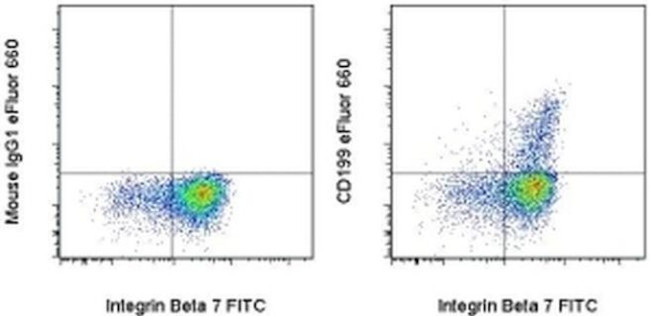Search Thermo Fisher Scientific
Invitrogen
CD199 (CCR9) Monoclonal Antibody (BBC3M4), eFluor™ 660, eBioscience™
FIGURE: 1 / 1
CD199 (CCR9) Antibody (50-1999-42) in Flow

Product Details
50-1999-42
Species Reactivity
Host/Isotype
Recommended Isotype Control
Class
Type
Clone
Conjugate
Excitation/Emission Max
Form
Concentration
Purification
Storage buffer
Contains
Storage conditions
Shipping conditions
RRID
Product Specific Information
Description: This BBC3M4 monoclonal antibody reacts with human CD199 (CCR9), a 7 transmembrane spanning G-protein-coupled receptor. CCR9 expression is regulated during thymic development and CCR9 deficiency results in mild impairment in thymocyte development. In the periphery, CCR9 and alpha 4 beta 7 integrin are upregulated in response to dendritic cell-derived retinoic acid, conferring preferential trafficking to gut-associated tissues. CCR9 is the receptor for CCL25 (TECK).
Applications Reported: This BBC3M4 antibody has been reported for use in flow cytometric analysis.
Applications Tested: This BBC3M4 antibody has been pre-titrated and tested by flow cytometric analysis of stimulated normal human peripheral blood cells. This can be used at 5 µL (0.25 µg) per test. A test is defined as the amount (µg) of antibody that will stain a cell sample in a final volume of 100 µL. Cell number should be determined empirically but can range from 10^5 to 10^8 cells/test.
eFluor® 660 is a replacement for Alexa Fluor® 647. eFluor® 660 emits at 659 nm and is excited with the red laser (633 nm). Please make sure that your instrument is capable of detecting this fluorochome.
Excitation: 633-647 nm; Emission: 668 nm; Laser: Red Laser.
Filtration: 0.2 µm post-manufacturing filtered.
Target Information
The protein encoded by this gene is a member of the beta chemokine receptor family. It is predicted to be a seven transmembrane protein similar to G protein-coupled receptors. Chemokines and their receptors are key regulators of the thymocytes migration and maturation in normal and inflammation conditions. The specific ligand of this receptor is CCL25. It has been found that this gene is differentially expressed by T lymphocytes of small intestine and colon, suggested a role in the thymocytes recruitment and development that may permit functional specialization of immune responses in different segment of the gastrointestinal tract. This gene is mapped to the chemokine receptor gene cluster region. Two alternatively spliced transcript variants have been described.
For Research Use Only. Not for use in diagnostic procedures. Not for resale without express authorization.
How to use the Panel Builder
Watch the video to learn how to use the Invitrogen Flow Cytometry Panel Builder to build your next flow cytometry panel in 5 easy steps.
References (0)
Bioinformatics
Protein Aliases: C-C chemokine receptor type 9; C-C CKR-9; CDw199; CDw199 antigen; chemokine (C-C motif) receptor 9; G protein-coupled receptor 28; G-protein coupled receptor 28; GPR-9-6
Gene Aliases: CC-CKR-9; CCR9; CDw199; GPR-9-6; GPR28
UniProt ID: (Human) P51686
Entrez Gene ID: (Human) 10803

Performance Guarantee
If an Invitrogen™ antibody doesn't perform as described on our website or datasheet,we'll replace the product at no cost to you, or provide you with a credit for a future purchase.*
Learn more
We're here to help
Get expert recommendations for common problems or connect directly with an on staff expert for technical assistance related to applications, equipment and general product use.
Contact tech support

